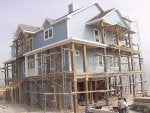I am a VERY new homebuilder (1 year, 3 homes). Among the next three we'll start before the end of the year is our own weekend place on the bay in Texas (Rockport).
This home is our gift to the next several generations OR the next major hurricane. Accordingly, we're trying to build this house (2 stories on pilings) to be around for as long as possible which should minimize a little of the movement.
What are your thoughts on rough natural wood floors (as opposed to laminate/vinyl plan/et al)? We REALLY want to find a way, if possible, to include real wood floors.
This is mostly a house movement/Texas coastal humidity question. We will minimize wet swimmers/wadefisherman by having plenty of living area on the ground floor.
Also of note....
No sand to worry about
My lab cleans up spilled margaritas quickly
We'll isolate the fridge, sink plumbing and dishwasher from the wood floor (something akin to a shower pan or hotwater heater pan?)
We don't mind the floors showing wear after time...it's a bayhouse, right?
Bathrooms will be tile
Great site full of some amazingly talented people.....thanks for your brains...
Fair Winds
This home is our gift to the next several generations OR the next major hurricane. Accordingly, we're trying to build this house (2 stories on pilings) to be around for as long as possible which should minimize a little of the movement.
What are your thoughts on rough natural wood floors (as opposed to laminate/vinyl plan/et al)? We REALLY want to find a way, if possible, to include real wood floors.
This is mostly a house movement/Texas coastal humidity question. We will minimize wet swimmers/wadefisherman by having plenty of living area on the ground floor.
Also of note....
No sand to worry about
My lab cleans up spilled margaritas quickly
We'll isolate the fridge, sink plumbing and dishwasher from the wood floor (something akin to a shower pan or hotwater heater pan?)
We don't mind the floors showing wear after time...it's a bayhouse, right?
Bathrooms will be tile
Great site full of some amazingly talented people.....thanks for your brains...
Fair Winds





